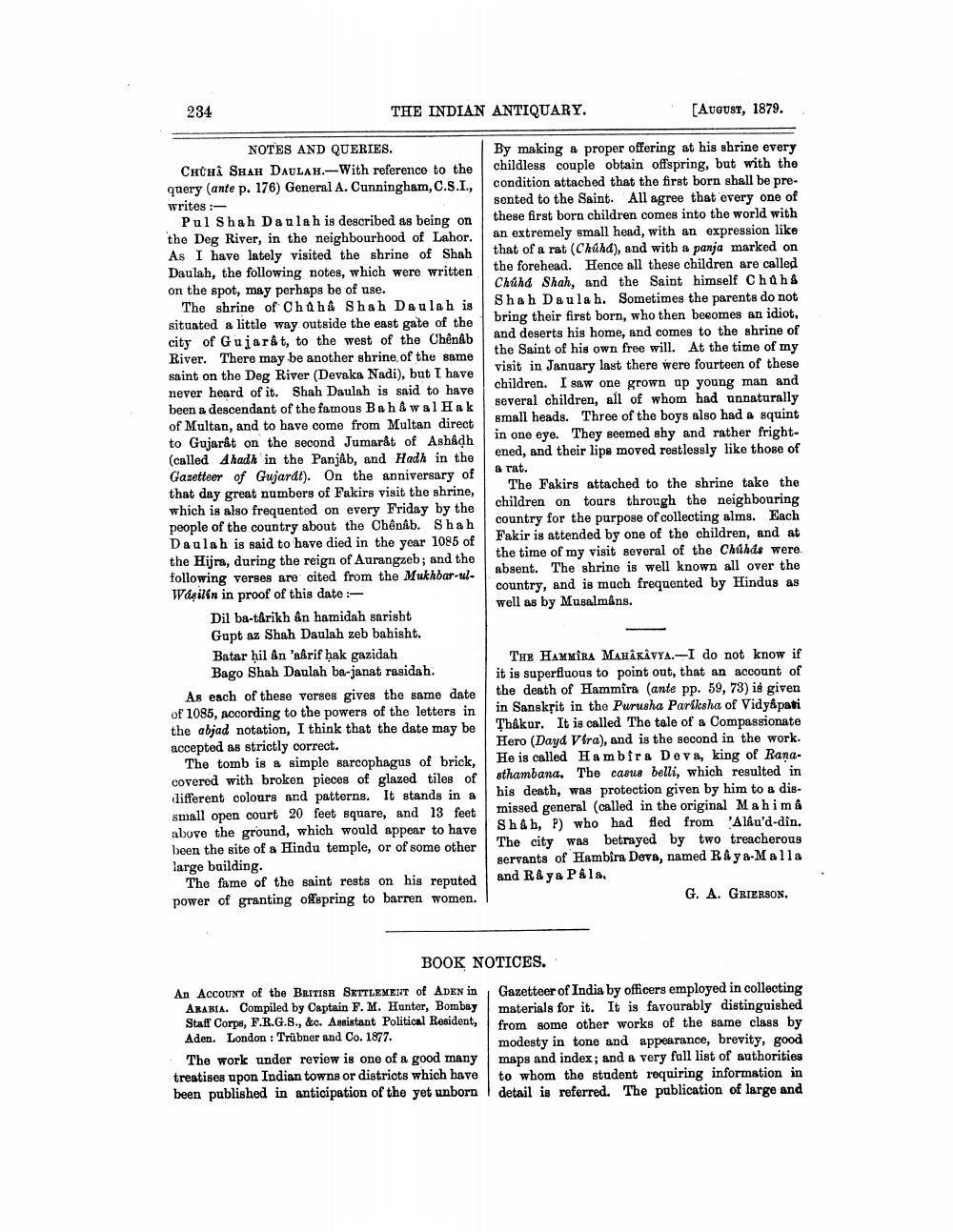________________
234
THE INDIAN ANTIQUARY.
NOTES AND QUERIES.
CHCHA SHAH DAULAH.-With reference to the query (ante p. 176) General A. Cunningham, C.S.I., writes:
Pul Shah Daulah is described as being on the Deg River, in the neighbourhood of Lahor. As I have lately visited the shrine of Shah Daulah, the following notes, which were written on the spot, may perhaps be of use.
The shrine of Chah& Shah Daulah is situated a little way outside the east gate of the city of Gujarât, to the west of the Chênâb River. There may be another shrine, of the same saint on the Deg River (Devaka Nadi), but I have never heard of it. Shah Daulah is said to have been a descendant of the famous Bah&wal Hak of Multan, and to have come from Multan direct to Gujarât on the second Jumarât of Ashadh (called Ahadh in the Panjâb, and Hadh in the Gazetteer of Gujarat). On the anniversary of that day great numbers of Fakirs visit the shrine, which is also frequented on every Friday by the people of the country about the Chênâb. Shah Daulah is said to have died in the year 1085 of the Hijra, during the reign of Aurangzeb; and the following verses are cited from the Mukhbar-ulWasilin in proof of this date:
Dil ba-târikh ân hamidah sarisht Gupt az Shah Daulah zeb bahisht. Batar hil an 'aârif hak gazidah Bago Shah Daulah ba-janat rasidah.
As each of these verses gives the same date of 1085, according to the powers of the letters in the abjad notation, I think that the date may be accepted as strictly correct.
The tomb is a simple sarcophagus of brick, covered with broken pieces of glazed tiles of different colours and patterns. It stands in a small open court 20 feet square, and 13 feet above the ground, which would appear to have been the site of a Hindu temple, or of some other large building.
The fame of the saint rests on his reputed power of granting offspring to barren women.
[AUGUST, 1879.
By making a proper offering at his shrine every childless couple obtain offspring, but with the condition attached that the first born shall be presented to the Saint. All agree that every one of these first born children comes into the world with an extremely small head, with an expression like that of a rat (Chúhd), and with a panja marked on the forehead. Hence all these children are called Chúhd Shah, and the Saint himself Chah& Shah Daulah. Sometimes the parents do not bring their first born, who then becomes an idiot, and deserts his home, and comes to the shrine of the Saint of his own free will. At the time of my visit in January last there were fourteen of these children. I saw one grown up young man and several children, all of whom had unnaturally small heads. Three of the boys also had a squint in one eye. They seemed shy and rather frightened, and their lips moved restlessly like those of a rat.
An ACCOUNT of the BRITISH SETTLEMENT of ADEN in ARABIA. Compiled by Captain F. M. Hunter, Bombay Staff Corps, F.R.G.S., &c. Assistant Political Resident, Aden. London: Trübner and Co. 1877.
The work under review is one of a good many treatises upon Indian towns or districts which have been published in anticipation of the yet unborn
The Fakirs attached to the shrine take the children on tours through the neighbouring country for the purpose of collecting alms. Each Fakir is attended by one of the children, and at the time of my visit several of the Chúhás were. absent. The shrine is well known all over the country, and is much frequented by Hindus as well as by Musalmâns.
BOOK NOTICES.
THE HAMMIRA MAHAKAVYA.-I do not know if it is superfluous to point out, that an account of the death of Hammîra (ante pp. 59, 73) is given in Sanskrit in the Purusha Pariksha of Vidyapati Thakur. It is called The tale of a Compassionate Hero (Dayá Vira), and is the second in the work. He is called Hambira Deva, king of Ranasthambana. The casus belli, which resulted in his death, was protection given by him to a dismissed general (called in the original Mahimâ Shah, P) who had fled from 'Alâu'd-din. The city was betrayed by two treacherous servants of Hambîra Deva, named R&ya-Malla and R&ya P&la..
G. A. GRIERSON.
Gazetteer of India by officers employed in collecting materials for it. It is favourably distinguished from some other works of the same class by modesty in tone and appearance, brevity, good maps and index; and a very full list of authorities to whom the student requiring information in detail is referred. The publication of large and




